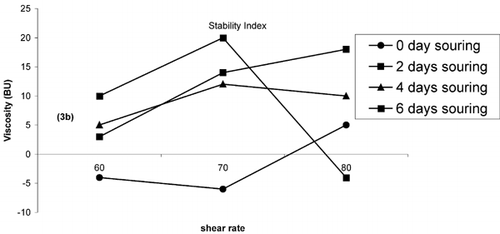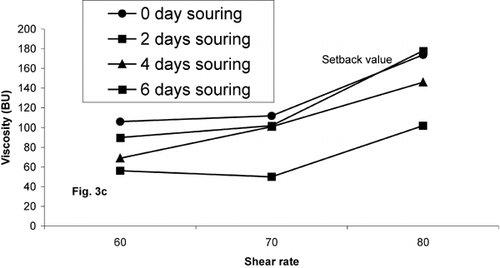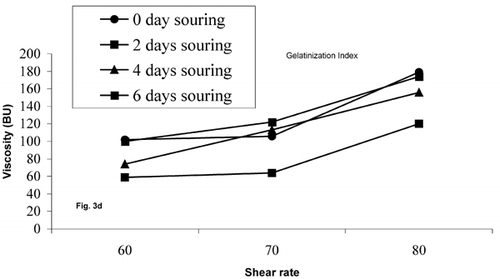Abstract
Maize flours were obtained by wet milling or dry milling processes in traditional fermented ogi flour with or without fortification with soy fractions. The rheological and paste characteristics of the products were assessed. Inclusion of soy fractions affected the rheological and paste characteristics of the products, specifically in improving the gelatinization index of the products. The products could be described as pseudoplastic, which increase in consistency value with increasing concentration of ogi flour. The consistency index (K) values are much lower in dry milled ogi flour than the wet milled ogi flour. This correlates the patterns of the peak viscosities of dry milled ogi flours compared to the wet milled ogi flour. Changes in rheological characteristics were more noticeable with increase in temperature and addition of souring (fermentation) water.
Introduction
Ogi is a fermented food product made traditionally by wet milling of maize, sorghum or millet grains. The processing is simple and common to most African countries especially West African countries.Citation[1] Ogi cake or flour can be reconstituted to thin consistency for feeding as weaning food for infants and breakfast cereal for adults.Citation[2] Citation[3] At much higher concentration the reconstituted ogi flour can gel and when cooled results into solid mass which is consumed as a real meal with all kinds of soups.Citation[4] Due to its nutritional value and its implication in the incidence of Kwashiorkor among infants, several studies have attempted to improve the quality of ogi by fortifying with legumes, animal proteins, and fruits.Citation5–7 Literature abounds on the rheological properties of foods.Citation8–11 However, information is scanty on the rheological characteristics of ogi as affected by fortification and other processing variables.Citation[12] There is therefore a need to characterize ogi in terms of its rheological properties in view of the importance of relating its rheological data to composition. There is a dearth of such rheological data. The objective of this study was to investigate the flow behavior of ogi at different temperatures and concentration and to determine the effect of soy addition, souring period, and method of preparation on the flow and paste properties.
Materials and Methods
TZSR‐W maize variety was purchased from IAR&T in Ibadan, Nigeria while soybean was purchased from a local market in Ile‐Ife, Nigeria; while defatted soy‐flour was obtained from TUNS Farm, a soy processing company at Oshogbo, Nigeria.
Preparation of Ogi
Ogi flour was produced using either wet‐milling or dry‐milling processes () as reported by Adeyemi and BeckleyCitation[13] with modification in the addition of soy fraction in the ratio 80:20 (maize:soy fraction) on dry weight basis.Citation[14] For the wet milling process, cleaned maize grains were steeped in water at ratio 1:2 (w/v) at room temperature (26 ± 2°C) for 2 days. The steeped grains were wet‐milled in a No.1 Premier mill and wet sieved followed by souring of the throughs while the overtails were discarded. The resultant ogi slurry was pressed inside a filter cloth bag to squeeze out excess water. The ogi cake was dried in a cabinet dryer at 45 ± 2°C and the dried cake was then milled in the Premier mill before packaging in polyethylene bag for storage.
Figure 1. Flow diagram of ogi manufacture by wet and dry milling methods including fortification with soy fractions.
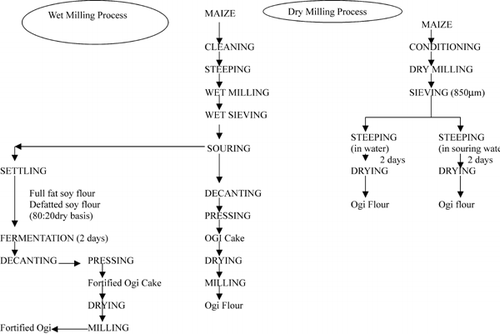
Using the wet milling method, different particle sizes of the wet milled mass and souring periods were investigated. For the former, sieving of the wet milled ogi slurry was done using five different types of sieves namely: the local sieve (cheese cloth), 212 µm, 300 µm, 425 µm, and 600 µm BS mesh sieves. All the samples were each soured for 2 days. For the souring period, the wet‐milled slurry obtained from 300 µm sieve was separately soured for 0, 2, 4, and 6 days, respectively and the resultant ogi flour was obtained by drying the mash as described earlier.
For dry milling method, thoroughly cleaned maize grains were conditioned by adding 3% (w/w) water to maize grains before dehulling. The dehulled grains were milled using the combination of Premier and pin disc mills. The milled maize was sieved using an 850 µm sieve and was divided into two lots. The first part was steeped in distilled water (1:2 w/v) and the other part was steeped in souring water (1:2 w/v) for 2 days. The samples were dried, milled, and stored.
Preparation of Soy Fractions, Soymilk, and Ogi–Soy Mixes
Cleaned soybeans were roasted in an air oven at 110°C for 1 hour after which they were soaked in water for 2 min. The soaked beans were cooked on a hot plate until the coats were softened and then decorticated manually followed by drying in a cabinet dryer at 45 ± 2°C for about 14 hours. The dried beans were then milled using a plate disc mill to obtain full fat soy flour.
For the preparation of soy milk, cleaned soybeans were soaked in 0.05% NaHCO3 solution (1:5 w/v) for about 12 hours, drained and blanched in boiling water containing 0.05% NaHCO3 for 30 min. The beans were drained, dehulled, and blanched in a mill with addition of water at ratio 4:1. The slurry was strained in a filter cloth bag to obtain raw soymilk and soy residue. The milk was boiled for 30 min, cooled and stored in the refrigerator prior to further studies.
Ogi slurry, obtained by the wet milling process from 300 µm sieve, was allowed to settle for 6–8 hours after which the supernatant was decanted. The resultant mass was mixed at ratio 80:20 on dry basis with either full fat or defatted soy flour. The mixtures were then separately decanted, pressed, and dried in the cabinet drier at 45 ± 2°C to obtain ogi–soy mixes. In the text and tables DFSF and FFSF refer to defatted soy flour and full fat soy flour, respectively.
Rheological Characteristics
Rheological characteristics of ogi at 8 kg solids/100 kg sample and 16 kg solids/100 kg sample levels were determined using a concentric cylinder viscometer (Haake RVS Rotovisco viscometer) at three temperatures (70°C, 80°C, and 90°C) and at the share rates up to and including 127.65 s−1. Temperature was controlled with the aid of a constant temperature circulator (Model LAUDA K4R Electronic Messgerate Werk Lauda). The samples were sheared first in the ascending order followed by the descending order of shear rates. From the linear regression analysis, Power Law model [EquationEq. (1)] was used to calculate consistency index, K, and flow behavior index, n.
Viscoamylograph Pasting Viscosity
Pasting characteristics of ogi suspensions in water (or soy milk) were determined using Brabender viscoamylograph. An 8 kg solids/100 kg sample or 16 kg solids/100 kg sample of ogi flour with 450 mL distilled water was placed in the bowl of the viscoamylograph and heated from 30°C to 90°C, held at 90°C for 15 min, cooled to 50°C with the rate of heating or cooling at 1.5°C/min and at speeds 60, 70, or 80 rpm. The viscoamylogram were evaluated as described by Banigo, deMan, and Duitschaever.Citation[15] All the viscosity values are the mean of duplicate measurements and are recorded as Brabender Units (BU).
Chemical Analysis
The moisture, ash and fat contents were determined according to AOAC.Citation[16] Nitrogen contents were determined by micro‐Kjeldahl method and nitrogen to protein conversion factor of 6.25 was used according to Kick and Sawyer.Citation[17] Carbohydrate contents were determined by the phenol‐sulfuric acid method.Citation[18] A CD70 potable pH meter (Walden Precision Apparatus Limited, Cambridge, UK) was used to read the pH.
Results and Discussion
Chemical Composition of the Products
The proximate chemical composition of ogi samples is presented in . The moisture content range of the samples was 9.17–10.24%. There was no significant difference in moisture content of ogi/DFSF and ogi/soymilk samples, which were significantly different from ogi/FFSF. Moreover, ogi/FFSF had the lowest carbohydrate content; the highest carbohydrate content was found in ogi/soymilk but lower in protein content. Ogi/FFSF had the lowest percentage ash. Fat analysis showed that ogi/FFSF had the highest (7.61%) with decreasing fat content for the other two samples depending on the processing method.
Table 1. Chemical composition (wet basis) of maize–soy ogi mixes
Rheological Properties and Milling Methods
The shear stress–shear rate data obtained for ogi slurry were plotted () and a fit was obtained with linear regression analysis using the power law model (). The shear stress–shear rate relationship of ogi slurry showed that the products could be described by power law model [EquationEq. (1)] with high r 2 and without improvement in statistical accuracy when Herschel‐Bulkley model was used to establish the occurrence of yield stress. The values of the consistency index, the flow behavior index and r 2 are presented in , which shows pattern of increasing K values with concentration and increasing temperature for ogi obtained by wet‐milling or dry‐milling process. The K values were found to be much lower in dry milled ogi flour than the wet milled flour for both increasing and decreasing shear limbs. The higher K values for wet milling indicate that the flour from this process resulted in a more pseudo‐plastic gel than from flour through the dry‐milling process probably due to the higher starch content of the wet milled samples.Citation[14]
Figure 2. A typical shear stress (τ) vs. shear rate (γ) plot of reconstituted ogi at 70°C (τ = 1.18γ 0.56; r 2 = 0.994).
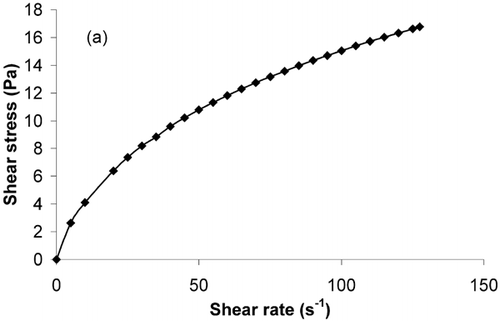
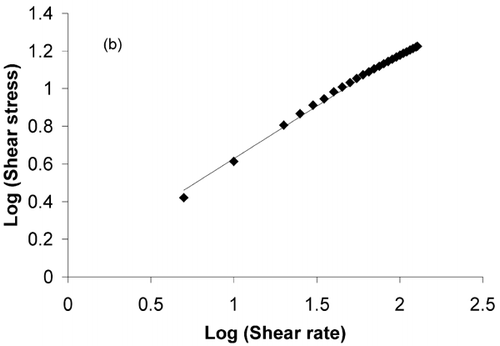
Table 2. Effect of milling method on consistency index (K) and flow behavior index (n) as a function of temperature at two concentration levels
Rheological and Pasting Characteristics of Ogi and Ogi–Soy Mixes
Comparison of the rheological characteristics () of the unfortified and fortified ogi flours showed significantly lower values of consistency index for ogi fortified with full‐fat soybean flour than ogi from unfortified maize flour. This is in agreement with observation made by Adeyemi, Akanbi, and FasoroCitation[14] in a three‐component maize‐banana–soy mix. Moreover, the K values increased with increasing concentration and temperature. However, the flow behavior index (n) decreased with increasing concentration and temperature. The difference in the consistency values could be due to the differences in water imbibing capacity. This is in conformity with the findings of Urbanski, Wei, Nelson, and StinbergCitation[19] on the influence of total and imbibed water on flour characteristics of soybean constituents. The rheological characteristic values are higher at the increasing shear rate than those values obtained during the decreasing shear rate; giving rise to hysteresis loop. This phenomenon could be due to the influence of previous shear against the viscometer wall, possibly leading to the breakdown of the macromolecules.
Table 3. Effect of soy fraction with ogi on consistency index (K) and flow behavior index (n) as a function of temperature at two concentration levels
The corresponding pasting characteristics of ogi flour and ogi–soy mixes are shown in . The highest gelatinization temperatures were recorded for ogi with full fat soy flour which could be due to the influence of lipid in forming complexes with starch components especially amylose.Citation[20] Citation[21] The peak viscosities of samples at 70 rpm are significantly higher than those at 60 rpm and 80 rpm, respectively. It can be seen that the peak viscosity of unfortified ogi is in the range 118–140 BU. Marked decreases in peak viscosity for samples with soy fractions were observed. Fortification with soy fraction caused lower peak viscosities; for instance, samples fortified with full fat soy flour had viscosity values of 78, 105, and 79 BU at 60 rpm, 70 rpm, and 80 rpm, respectively. This was followed by samples with soymilk (94–110 BU) and defatted soy flour (101–119 BU). This observation is in agreement with viscoelastic nature of starch gels containing components capable of modifying the imbibing capability of starch especially lipids which cause a higher pasting temperature and a lower starch paste viscosity.Citation[1] Stability index (a measure of the fragility of starch) also decreased with addition of defatted soy flour and full fat soy flour, which could be due to high viscosities after holding at 90°C for 15 min. Moreover, the data reveal that the samples were more stable at low speed than at high speed suggesting that granules breakdown is more at high shear rate with consequent decrease in starch gel stability. However, high set back value and gelatinization index were recorded at 80 rpm. This phenomenon may be attributed to cooperative action of starch component during heat treatment.Citation[22]
Table 4. Effect of soy fraction on the pasting characteristics of ogi
The pasting properties of ogi fortified with either full fat soy flour or defatted soy flour could be used for “Agidi” (a solid mass gel) preparation as indicated by high values of gelatinization index.Citation[4] Citation[15] Ogi flour fortified with soymilk would be preferable for ogi porridge in thin consistency.Citation[23] The pasting characteristics of dry milled ogi flour in souring water have significantly lower peak viscosities (6–12 BU) compared to samples steeped in water (10–18 BU). These values are 6–8 times less than the values for the wet milling processes. This supports the already known effect of higher damaged starch in dry‐milled ogi with consequent reduction in water hydration.Citation[24] This indicates that while it is possible that the souring water (pH 4.72–5.42) could lead to reduction in viscosity, the generation of this souring water during fermentation of maize slurry is more effective in lowering viscosity through possibly hydrolysis of starch in this acidic medium.Citation[13] It can be observed that dry milled samples have much higher viscosities when held at 90°C for 15 min. The high resistance of dry milled samples may be due to time lag needed for water to enter the crystal lattices of the starch granules.
Effect of Particle Size on Pasting Characteristics
Data in show that the peak viscosities of ogi flour made from flour with <600 µm particle size are higher than other sizes at the three shear rates. The more significant influence of the particle size is the viscosity on cooling to 50°C, which affects the setback value and gelatinization index. On holding at 90°C, samples made from other particle sizes have viscosities about 5.3–10.8% lower than that of samples with <600 µm particle size. This may account for its strength in porridge preparation. Similar patterns have been reported for pasting characteristics of sorghum and maize starches.Citation[12] Citation[25] Citation[26]
Table 5. Effect of particle size on pasting characteristics of ogi flour
Souring Period and Souring Water Effect on Flow Characteristics and Pasting Viscosity
A factor that is important in ogi taste is how tart the ogi is to taste. This is a function of souring period. Souring period was found to affect the behavior of ogi slurry during shearing (). There was a noticeable significant change in consistency index at the two concentrations between the 0‐day and 2‐day soured ogi. However, the corresponding change at the 6th day of souring was not significantly different. This would appear to support our observation that souring for 2 days as practiced by some commercial processors is ideal for ogi manufacture. This pattern could be due to the change in pH and the presence of some ions such as acetate, which have been reported to affect greatly starch swelling.Citation[13] Citation[15]
Table 6. Influence of souring period on consistency index (K) and flow behavior index (n) of ogi at two concentration levels and 70°C
The corresponding pasting viscosity data also indicated that the highest paste viscosity was recorded for 0 day soured ogi and decreased with increase in souring period (), which is in agreement with our earlier findings.Citation[13] Citation[25] This probable interaction of products of fermentation with the starch granules, however, influenced the pattern of change of other pasting characteristics such as stability index, setback value, and gelatinization index [see ].
Conclusion
The shear stress‐ shear rate data of ogi porridge (gel) indicated that ogi could be described as pseudoplastic as determined from the power law parameters. The consistency value and flow behavior index are affected by concentration and temperature. It has also been shown that wet milling process of maize produces ogi porridge of higher viscosity than that from dry milling process, even when souring water is added to maize flour from the latter process. In addition, fortification with soy fractions could improve the rheological characteristics of ogi products. Thus, while ogi fortified with either full‐fat soy flour or defatted soy flour will give a low peak viscosity, the gain in fortification is improvement in gelatinization index especially the product eaten as the solid mass with stew or “akara” (a local traditional cake made from beans or melon). Moreover, the process of souring is quite critical in effecting much desired tartness and its influence on rheological properties.
References
- Nago , M. C. , Hounhouigan , J. D. , Akissoe , N. , Zanou , E. and Mestres , C. 1998 . Characterization of Beninese traditional ogi, a fermented maize slurry; physico‐chemical and microbiological aspects . Int. J. Food Sci. Technol. , 33 : 307 – 315 .
- Banigo , E. O.I. and Muller , H. G. 1972 . Manufacture of ogi (a Nigerian fermented cereal porridge): comparative evaluation of corn, sorghum and millet . Can. Inst. F. Sci. Tec. , 5 : 217 – 221 .
- Ekpeyong , T. E. 1980 . Biological evaluation of improved local maize hybrids using rats . Food Chem. , 6 : 133 – 137 .
- Akingbala , J. O. , Rooney , L. W. and Faubion , J. M. 1981 . A laboratory procedure for the preparation of ogi, a Nigerian fermented food . J. Food Sci. , 46 : 1523 – 1526 .
- Akinrele , I. A. 1970 . Fermentation studies on maize during the preparation of a traditional African starch—cake food . J. Sci. Food Agr. , 21 : 619 – 625 .
- Fashakin , J. B. , Awoyefa , M. B. and Fourst , P. 1986 . The application of protein concentrates from locally available legumes in the development of weaning foods . Z. Ernahrungswiss , 25 : 220 – 227 .
- Adeyemi , I. A. and Soluade , E. O. 1993 . Development and quality evaluation of pawpaw‐ogi . Plant for Human Nutrition , 44 : 213 – 220 .
- Steffe , J. F. 1996 . Rheological Methods in Food Process Engineering , 2nd Ed. 367 – 370 . East Lansing , , USA : Freeman Press .
- Zaitoun , S. , Ghzawi , A. A. , Al‐Malah , K. I.M. and Abu‐Jdayil , B. 2001 . Rheological properties of selected light coloured Jordanian honey . Int. J. Food Prop. , 4 : 139 – 148 .
- Abu‐Jdayil , B. , Jumah , R. Y. and Shaker , R. R. 2002 . Rheological properties of a concentrated fermented product, Labney, produced from bovine milk: effect of production method . Int. J. Food Prop. , 5 : 667 – 679 .
- Alhamdan , A. A. 2002 . Rheological properties of a newly nutritious dairy drink from milk and date extract concentrate (dibbs) . Int. J. Food Prop. , 5 : 113 – 126 .
- Osungbaro , T. O. 1990 . Effect of differences in variety and dry milling of maize on textural characteristics of ogi and agidi . J. Sci. Food Agr. , 52 : 1 – 11 .
- Adeyemi , I. A. and Beckley , O. 1986 . Effect of period of maize fermentation and souring on chemical properties and amylograph pasting viscosity of ogi . J. Cereal Sci. , : 353 – 360 .
- Adeyemi , I. A. , Akanbi , C. T. and Fasoro , O. G. 1991 . Effect of soy fraction on some functional and rheological properties of maize‐banana mixtures . J. Food Process. and Pres. , 15 : 31 – 43 .
- Banigo , E. O.I. , de Man , J. M. and Duitschaever , C. L. 1974 . Utilization of high‐lysine corn for the manufacture of ogi using a new improved processing system . Cereal Chem. , 51 : 559 – 573 .
- 1990 . Official Methods of Analysis , 15th Ed. Washington D.C., Virginia , , USA : Association of Official Analytical Chemists . A.O.A.C
- Kirk , R. S. and Sawyer , R. 1991 . Pearson's Composition and Analysis of Foods 16 – 21 . Longman Group UK Limited .
- Dubois , M. , Gilles , K. A. , Hamilton , J. K. , Rebers , P. A. and Smith , F. 1956 . Colorimetric method for determination of sugars and related substances . Anal. Chem. , 28 : 139 – 142 .
- Urbanski , G. E. , Wei , L. S. , Nelson , A. I. and Stinberg , M. P. 1983 . Rheology models for pseudoplastic soy systems based on water binding . J. Food Sci. , 48 : 1436 – 1439 .
- Soulaka , A. B. and Morrison , W. R. 1985 . The amylose and lipid contents, dimensions and gelatinization characteristics of some wheat starches and their A and B‐granule fractions . J. Sci. Food Agr. , 36 : 709 – 718 .
- Swinkels , J. J.M. 1985 . Composition and properties of commercial native starches . Starch‐Starke , 37 : 1 – 5 .
- Kruger , L. H. and Murray , R. 1976 . “ Starch texture ” . In Rheology and Texture in Food Quality Edited by: deMan , J. M. , Voisey , P. W. , Rasper , V. F. and Stanley , D. W. 427 – 444 . Westport , Connecticut : AVI Publishing Company Inc. .
- Iluyomade , F. F. 1991 . Effect of Soy‐Fraction on Some Quality Characteristics of “Agidi” a Maize Gel Ile‐Ife , , Nigeria : Department of Food Science and Technology: Obafemi Awolowo University . B.Sc. Thesis
- Yasunaga , T. , Bushuk , W. and Iruine , G. N. 1968 . Gelatinization of starch during bread making . Cereal Chem. , 45 : 269 – 279 .
- Adeyemi , I. A. 1983 . Dry‐milling of sorghum for ogi manufacture . J. Cereal Sci. , 1 : 221 – 227 .
- Fortuna , T. , Januszewska , R. , Kielski , A. and Palasinski , M. 2000 . The influence of starch pore characteristics on pasting behaviour . Int. J. Food Sci. Technol. , 35 : 285 – 291 .

